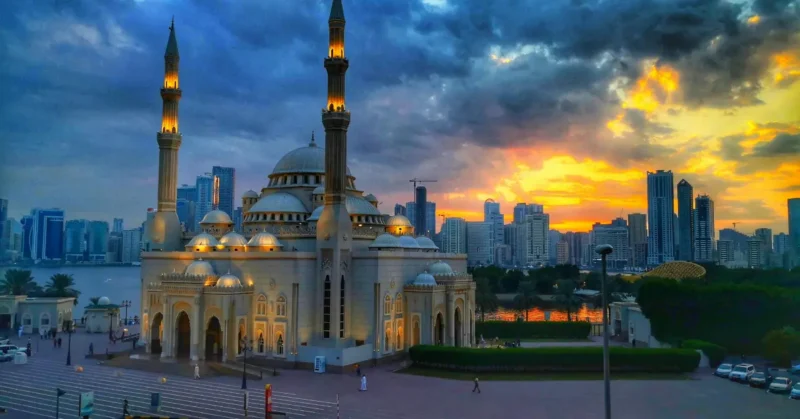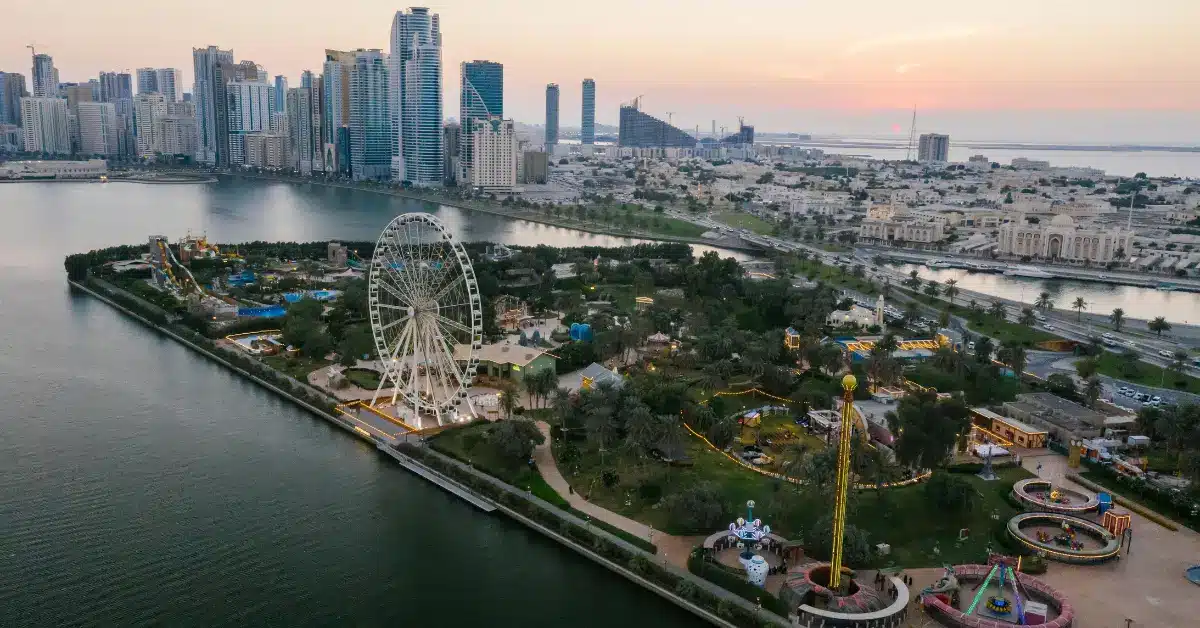King Faisal Mosque is one of Sharjah’s most recognised religious and cultural landmarks, and it stands out for its scale and serene atmosphere. This guide brings together everything you need to know about visiting King Faisal Mosque in 2025, from entry rules and tours to location, best times to visit, and nearby attractions.
- What makes the King Faisal Mosque a landmark in Sharjah
- Where the King Faisal Mosque is located and how to get there
- Entry rules, dress code, and visiting essentials
- Tours, experiences, and what you can explore inside
- Nearby places to visit after the King Faisal Mosque
- Key takeaways
- FAQs

What makes the King Faisal Mosque a landmark in Sharjah
As Sharjah’s largest mosque, King Faisal Mosque can accommodate up to 17,000 worshippers at once and blends contemporary Islamic architecture with traditional design elements. The mosque is known not only for its size but also for its calm, welcoming environment. It is also worth noting that it is named after King Faisal bin Abdul Aziz Al Saud of Saudi Arabia, honouring his support for Sharjah’s development.
Construction began in 1984 and was completed in 1987 under the design of architect Yusuf Abdelki, who envisioned an open, light-filled space that reflects the spiritual rhythm of the city.
Where the King Faisal Mosque is located and how to get there
King Faisal Mosque sits at the intersection of King Faisal Road and Al Arouba Street, right in the heart of Sharjah. Its central setting places it close to some of the city’s busiest areas, such as the Central Bus Station, Al Jubail Souq, Al Ittihad Park, and the Dubai Islamic Bank headquarters.
Being in a well-connected district makes the mosque easy to reach, whether you’re arriving by bus, taxi, or private car. If you’re arriving by car, there is ample parking around the mosque, especially near the main entrances.
How to reach the King Faisal Mosque from popular areas
- If you’re travelling from popular places in Abu Dhabi, such as Yas Waterworld, you can reach King Faisal Mosque either by taxi or by combining the metro with bus routes that lead into Sharjah.
- The mosque is also directly accessible via Sharjah’s Central Bus Station, which makes it simple for city visitors to arrive without needing a car.
- Those driving in from Dubai usually take the E11 route before entering Sharjah’s central district, which brings you within minutes of the mosque.
Entry rules, dress code, and visiting essentials
Visiting King Faisal Mosque is straightforward, but knowing the key entry rules and etiquette can help you enjoy a comfortable and respectful experience.
Entry and dress code
Entry to King Faisal Mosque is free for all visitors, and no booking is required for independent visits. The mosque keeps its doors open daily, making it easy to plan a visit at your own pace.
The dress code follows traditional modest standards. Men should cover their arms and legs, while women should cover their heads, arms, and legs. Abayas and headscarves may be available at the entrance, depending on availability. Like most mosques, you will need to remove your shoes before entering the prayer halls.
Best time to visit
If you want the most peaceful experience, early mornings or late afternoons are ideal. Visitors looking for a quieter atmosphere should avoid Ramadan evenings as the mosque becomes very busy around prayer times.

Tours, experiences, and what you can explore inside
Once you step inside the mosque, there’s a lot more to discover beyond its grand exterior, offering visitors a mix of cultural insight and peaceful spaces.
Tours
Guided tours are optional, but they can give you deeper insight into the mosque’s architecture, design philosophy, and cultural relevance. Many visitors enjoy exploring the mosque library, which houses books related to Islamic culture, Sharia, Hadith, and Islamic thought.
Atmosphere and facilities
Inside, the atmosphere is intentionally serene to encourage reflection. Separate designated areas are provided for men and women. The site also includes maintenance offices and a women’s charity association office.
Photography and conduct
Photography is generally allowed in specific areas. As with most religious sites in the UAE, drone photography requires permits and should not be attempted without approval. Visitors are encouraged to maintain respectful behaviour and avoid anything that might disrupt ongoing worship.

Nearby places to visit after the King Faisal Mosque
One of the advantages of visiting King Faisal Mosque is how close it is to other well-known spots in Sharjah. Central Souq, Al Jubail Souq, and several parks sit within a short distance, making it easy to pair your mosque visit with other activities.
If you’re exploring with family, it’s worth checking out some of the nearby family-friendly parks in Sharjah for a relaxed stroll or a break after your visit.
Cafés and eateries are easily accessible around the area, but eating is not allowed inside the mosque’s prayer halls.
Key takeaways
King Faisal Mosque remains one of Sharjah’s most significant cultural and religious spaces. Its central location, accessibility, free entry, and welcoming atmosphere make it a comfortable place for both worship and cultural appreciation.
With guided tours, a well-stocked library, and nearby attractions, it’s a destination that blends history, spirituality, and convenience effortlessly. Whether you are visiting the UAE or living here, you have to pass by this mosque.
FAQs
Yes, the mosque welcomes visitors of all faiths. Modest dress and respectful conduct are required.
No, entry is completely free. Donations for mosque upkeep are optional.
Men should cover their arms and legs. Women should cover their heads, arms, and legs. Abayas and scarves may be available at the entrance.
The best times are early morning or late afternoon, outside prayer hours. For a calm experience, avoid Ramadan evenings.
Yes, tours are available and can be arranged for groups, but no booking is required if you simply want to visit independently.